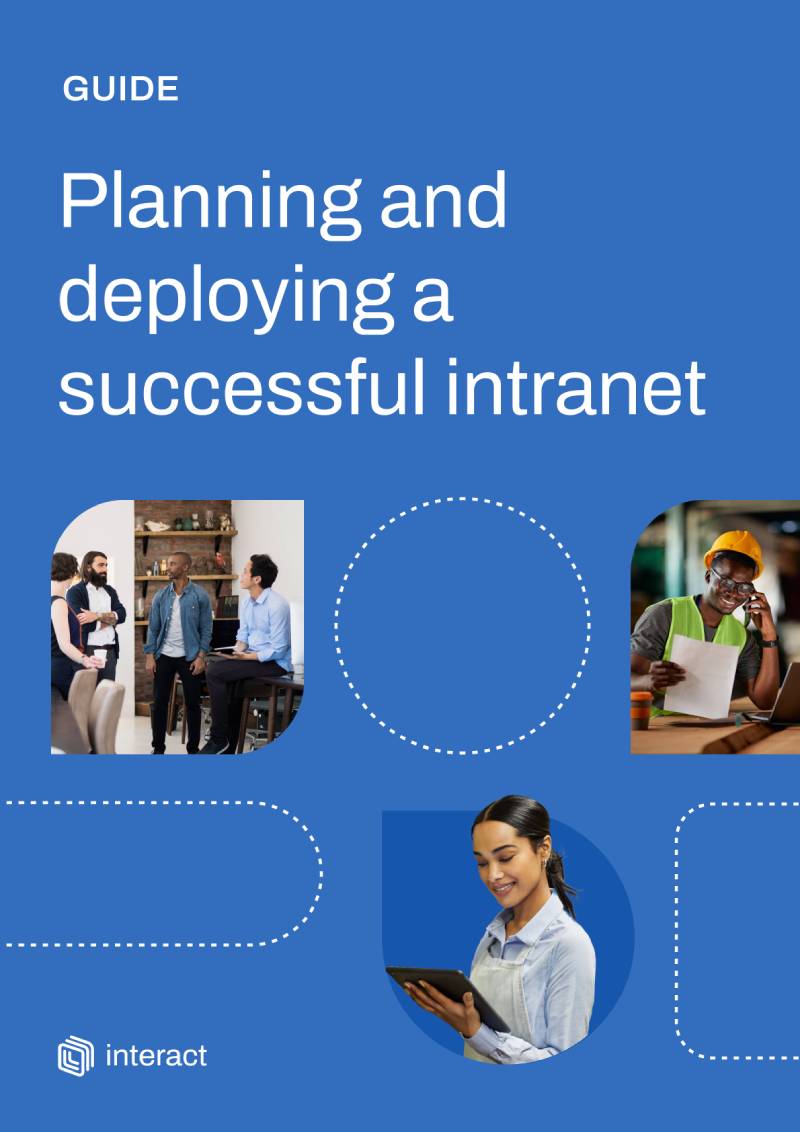The average intranet needs to fulfill a lot of functions to aid connection, communication, and access information within your organization. But with so many objectives, what are the essential intranet features that you should focus on?
When you’re building your intranet, it’s important to have a definitive list of the goals you want to achieve. Careful consideration of every essential component is critical if you’re going to create a powerful platform that can transform the way your employees interact and information is dispersed within your organization. Creating an intranet that does everything you want it to do is a tall order. Fortunately, with the help of our customers around the world, we’re handpicking seven intranet features that can help you deliver a successful project.
An intranet can act as an internal communications platform, a file management system, a place to collaborate, or to carry out a business process. But within all these things is the user’s journey, their impression of the functionality, usability, feel, and relevancy of everything they encounter as they move through the system. It is this journey that should be at the forefront of every intranet strategy.
Because the user journey is so important, the intranet is a continual work in progress, reshaping, and adapting to the workforce’s requirements. But amid this progression, some needs are constant. Employees will always need to communicate with each other, find information, carry out an operation essential to their role. These core purposes should form the foundations of your project and inspire your intranet’s essential features.
With clients around the world, we have countless intranet stories – of the successes, the challenges, and the lessons learned by organizations, both big and small. Having recently celebrated the tenth anniversary of our annual Excellence Awards, we’ve compiled the most important intranet features that every platform should include.
The top-ranking features your intranet needs
This is by no means an exhaustive list. Depending on the nature of the organization, its ambitions, size, and culture, there are many elements that make up a successful intranet. These are just some of the important intranet features that we’ve come across: the success stories that have changed businesses, transforming the way their employees interact, access information and fulfill their roles.
#1 Evidence-based design
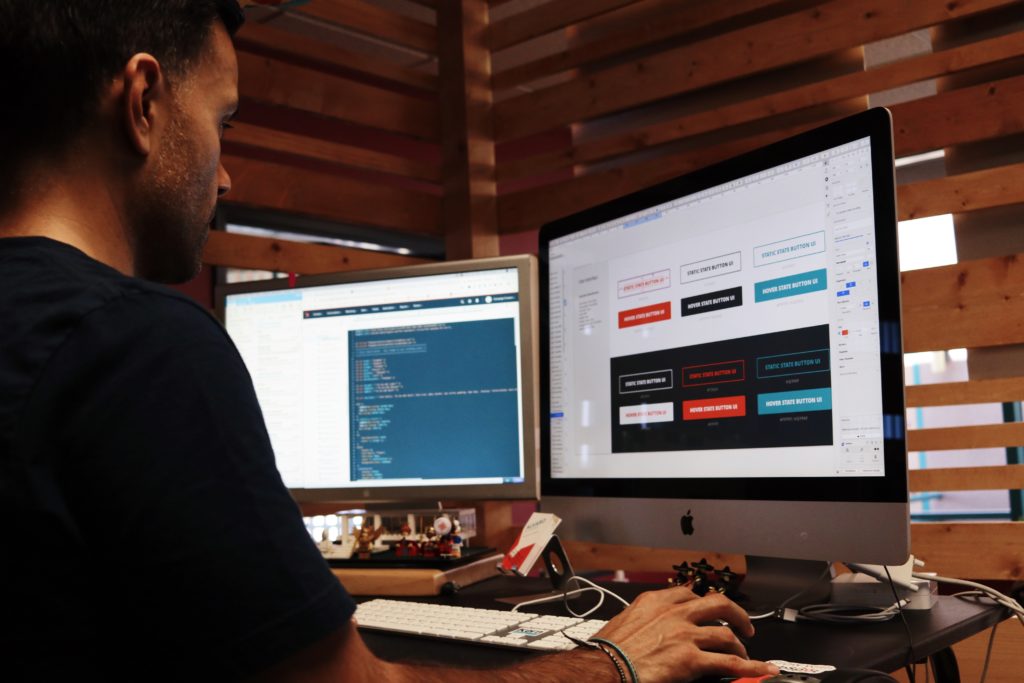
While they may perform similar duties, no two intranets are the same. This is because each intranet should be designed with its specific workforce in mind. While an intranet team may have experience and expertise in building a system that can have a significant impact on the workforce, no one can successfully predict user behavior. So to achieve this, the intranet team needs to carry out strategic and methodical research, the bulk of which involves taking onboard staff feedback and listening to the wants, needs, and habits of those prospective users.
Example: With over 38,000 students studying across six faculties and 12 research centers, Manchester Metropolitan University is one of the leading tertiary educators in the UK. Its legacy intranet lacked proper governance, and with little attention paid to maintenance and engagement, the system was unused.
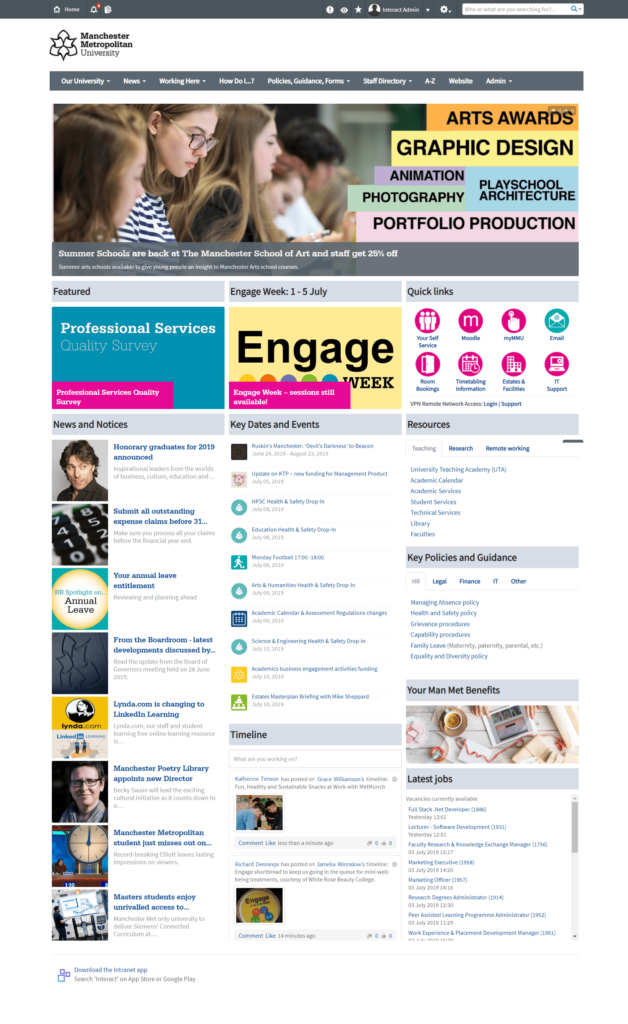
One of the University’s main focuses was to build a system that met the needs of its staff. To test the new structure and navigation, the team did online testing with their colleagues. This helped determine where content should live, how to label it, and the journeys that staff take to get to what they need. The intranet homepage continues to be shaped by users’ thoughts and opinions, with layout, content, and quick links determined by their needs. Using analytics and gathering staff feedback, the team has improved the type, quality, and timeliness of news items to drive a 35% increased readership of news stories between September and November 2019 compared with the year before.
#2 One source of truth

For a workforce to accept an intranet, it needs to act as an essential tool for their operations. There are many ways of achieving this, but the most significant component is to model the platform as the one source of truth. A lot of intranets fall out of favor by becoming a file depository – where obsolete and outdated documents sit beside more current ones.
The user’s journey to get to the right information is circuitous and inefficient and can leave considerable room for error. However, when it houses only correct, up-to-the-minute information, you create a reputation for your intranet being reliable, accessible, and indispensable to the user’s needs.
Example: As the company behind AMC, BBC AMERICA, IFC, SundanceTV, WE tv, and IFC Films, AMC Networks has a critical requirement to provide their 2,000+ employees with everything they need to carry out their jobs wherever they in the world. Their intranet’s role, among other things, is to act as a global hub of information and collaboration to connect employees and provide the information, tools, and resources they need.

This was achieved by creating five main areas: Our Story (for company overviews and leadership bios), For You (for human resources and benefits), Resources (for tools and applications), What’s Happening (for news and events), and People & Places (for the directory and rooms). These sections provide the information to empower their employees to get their jobs done as successfully as possible and also learn about events, the company, the industry, and each other.
#3 An HR focus

The inquiries that an average HR department fields is a broad church. From questions regarding leave to pay queries, performance to health and safety, it can be one of the busiest departments in the workplace.
An intranet can support HR professionals by allowing employees to self-serve and find information by themselves – all without having a direct conversation with an HR member. This saves time, reduces the burden on the department, and encourages workers to use the intranet as an essential tool.
Example: As the largest integrated property services group in the UK, Countrywide employs more than 10,000 people in over 850 branches. Creating a system in place to connect all these employees in dispersed locations was achieved through their intranet, Our Place. With the system in place, Countrywide could focus on streamlining HR processes and save a significant amount of administration time. One of their tasks was creating a number of self-help pages, allowing users to find answers to their HR queries. Since these pages went live, there has been a 66% reduction in HR queries, and an improvement in SLA (time to serve colleagues) from 80% to 99.5%.
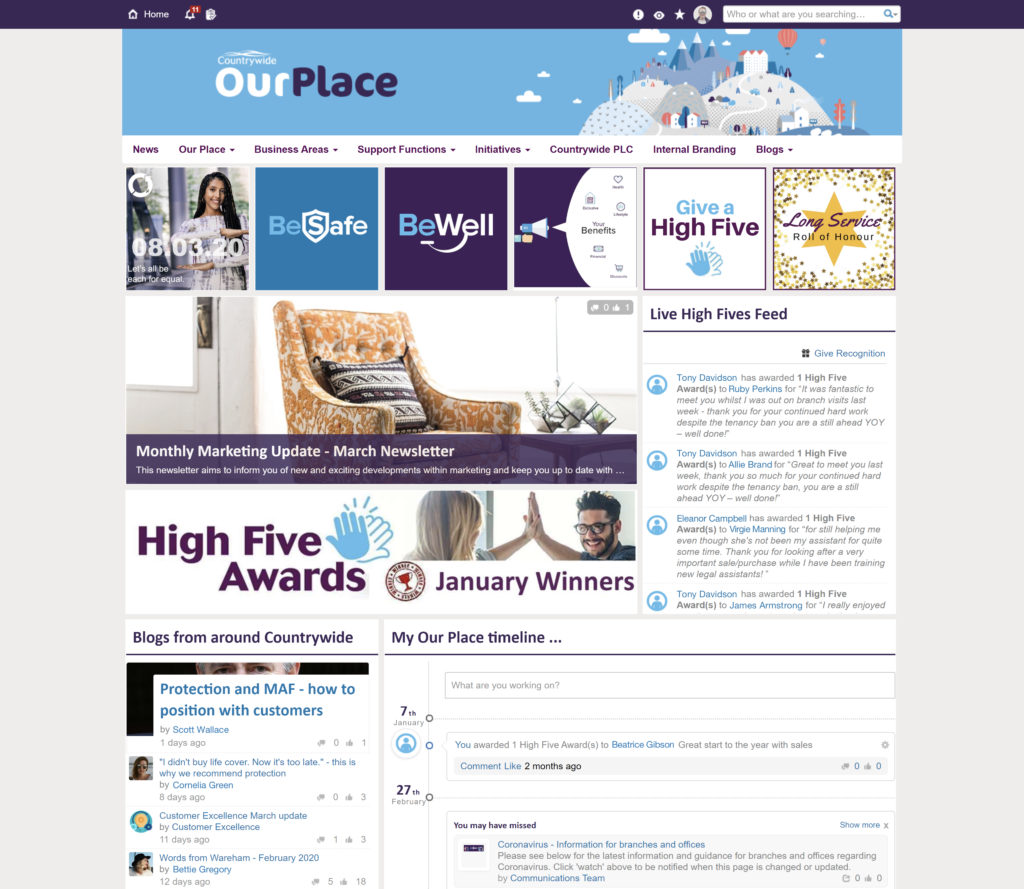
And it’s helped in other ways too – HR initiatives have been campaigned and promoted throughout the system. The internal recruitment referral program, in particular, has saved the business around £600,000 (USD 752,577) in recruitment costs.
#4 Accessibility

It’s all very well having an intranet that is well engaged with in the office. But when your workers are dispersed, or on the frontline, access is mitigated. For those who are customer-facing, working alone, or geographically distant, an intranet is key to providing support, advice, a sense of community, and access to vital information. Even for an entirely in-house workforce, access to the intranet may be required around the clock. For this reason, a mobile app is essential for every organization.
Example: Imperial College Healthcare NHS Trust has 12,000 employees across five hospitals, providing care for over a million patients each year. Imperial College Healthcare NHS Trust operates in a highly pressurized and regulated sector, requiring a careful balance between efficiency, safe clinical care, and good patient experience. Its busy A&E units must meet national waiting time targets while ensuring information is easily accessible, to help staff care for a continuous flow of patients. In this environment, employees must get access to the information they need.
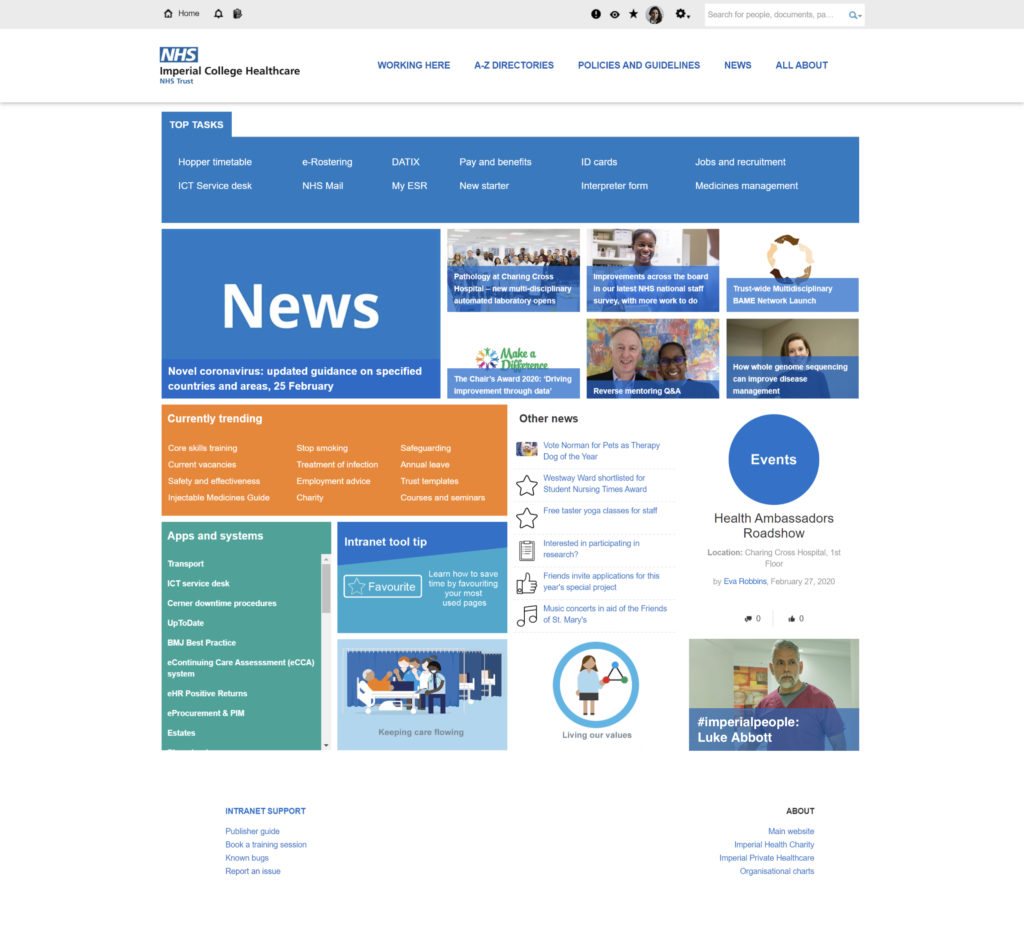
With the creation of their intranet, the team realized how an app would be a significant boon to their operations. By providing frontline staff access from devices other than Trust PCs, information, communication, and clinical documents that directly support patient care, the Trust has become more connected than ever before.
#5 Blogs

One of the primary aims of an intranet is to provide a place for employees to communicate and connect. While top-down information is essential to internal comms, what encourages staff engagement is an intranet that gives them a voice. The democratization of this platform manifests itself in forums, social commenting, and, most importantly, blogs. Blogs are the keystone of employee participation on the intranet. They not only enable the employee to provide thoughts, opinions, stories, and suggestions but also allow colleagues to understand their peers better.
Example: Operating in more than 30 countries with about 10,000 colleagues across the world, Travelex services currently span across Asia, Europe, North America, South America, Africa, and Australasia. This global reach poses a few challenges in keeping everyone connected despite language barriers and time zones. The inclusion of employee blogs in their intranet, The Lounge, has transformed the way employees interact with each other.
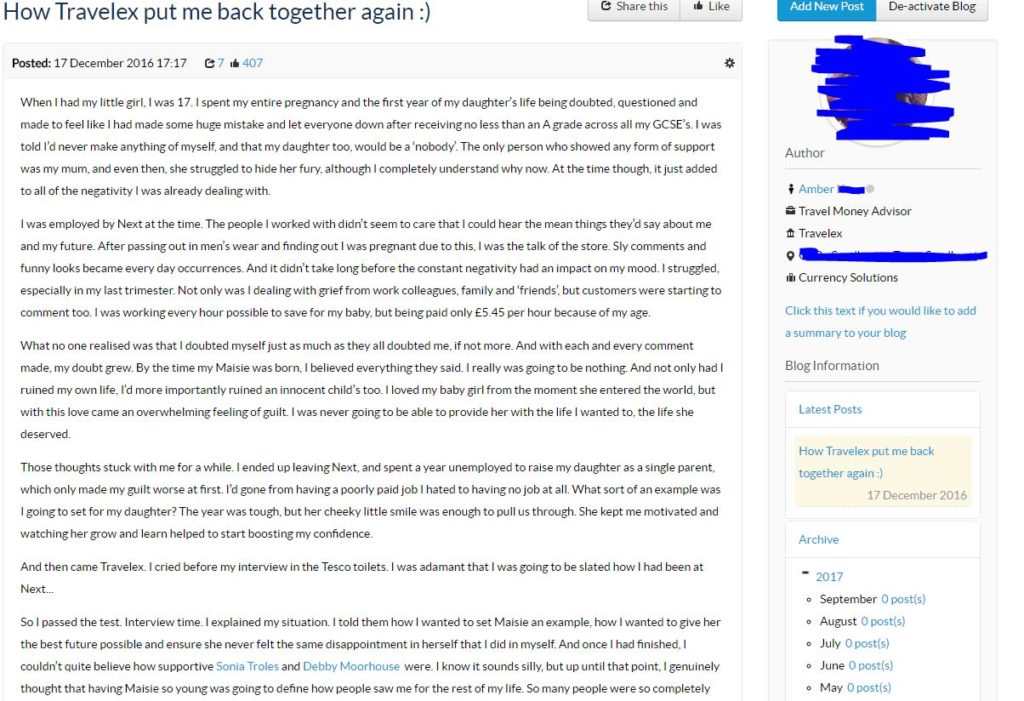
In the intranet’s first year alone, over 4,000 blogs were posted, ranging from executive updates to frontline staff sharing experiences or appealing for support. Topics are often a mixture of business and personal, with employees seeking help for various issues and problems. To further encourage employee-generated content, Travelex runs a ‘Blog of the Week’ feature in recognition of those who contribute and an annual ‘Blog of the Year’ with a voucher for the winner. Social tools such as commenting and sharing enable staff to support others and encourage engagement.
#6 A great user experience

While your intranet might contain all the relevant information needed for your organization, engagement will suffer without providing your employees with a good digital experience. This encompasses a number of elements – usability, intuitive layout, the incorporation of internal branding, the integrations of third-party apps, and the balance of work-related content and social interactions, amongst other things.
A great digital employee experience is what makes workers not only want to use the intranet, but also interact and put their own stamp on it.
Example: Sony PlayStation’s legacy intranet SID had all the ingredients of an essential intranet – with none of usability and functionality. Its successor, The Hub, was built to allow the use of the company intranet to be an enjoyable and rewarding experience – in much the same way the general public regards their products. Mirroring their external branding, the team set about reducing the gap between their products and the internal environment.
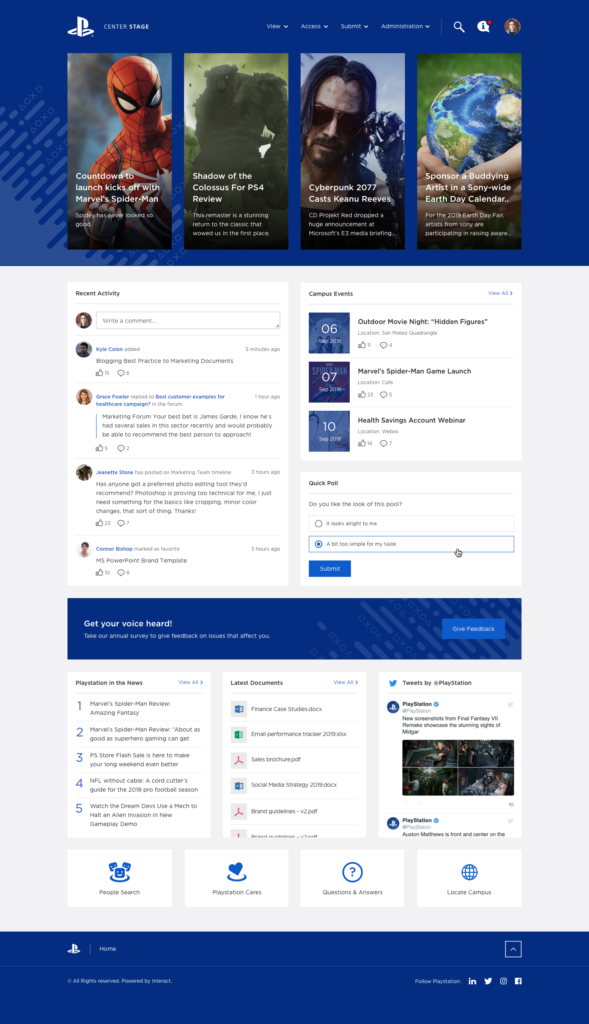
Brand guidelines were set up to provide consistent formatting to news articles, updates, and information. A personalized approach was undertaken, whereby each user accesses a homepage unique to them containing relevant information, unlike the ‘everyone sees everything’ method of the previous incarnation. A month after the launch of The Hub, the intranet team carried out a survey. They discovered that employees who agree that the intranet as a whole accurately reflects PlayStation shot up by 45% from a shocking 22% in 2018 to 67% in 2019.
#7 A social aspect

While intranets are essential for work-related content, they must facilitate social interactions too. Any business maintaining a platform for strictly corporate use may be fighting a losing battle. With social technology seeping into a large number of applications in both our personal and professional lives, the distinctions between the two are blurring. And in a world where working from home is becoming more widespread, and organizations are working out ways of minimizing isolation and disconnect, social technology is becoming more of a necessity.
Simply put, employees need – social intranet features in their digital workplace experience. Introducing these components to your intranet through the use of comments, tagging, likes, emojis, and so on, enables more natural connections and collaboration among employees, regardless of location.
Example: Equinox is a fitness company with 103 clubs across the US, Canada, and the UK. The organization has worked hard to create a culture that helps bring their 13,000 members of staff together and feel part of a work “family”. Its intranet team was determined to bring this to their intranet, EQX Connect. They envisioned a content area that was expressly designed to share employee stories and foster a sense of community.
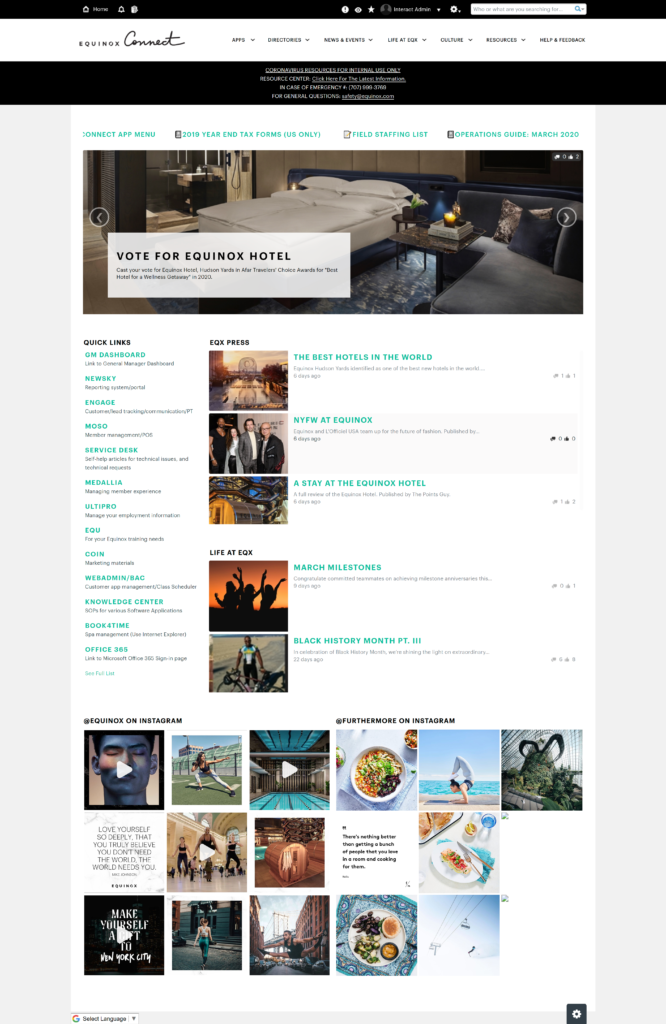
This section of the intranet, which became known as ‘Life at EQX’, includes rewards and recognition features, a monthly message from members of the leadership team, and the celebration of promotions, birthdays, anniversaries, and milestones. It is where team members can celebrate and get to know each other, experiencing an authentic sense of connection to each other and the brand. It has become so popular that Life at EQX has earned the leading number of likes over all other content areas, boasting over 33,000 visits overall with 206 employees spotlighted and 908 milestones celebrated.
An intranet’s role is to solve the needs of the employee by offering timely and relevant information and support. Its functions have changed a lot over the years, as businesses become more globalized and employees more dispersed. Organizations are trying to overcome radically different challenges than the ones they faced even a decade ago. And therefore, finding an intranet provider that can bend and adapt to these changing times is critical to long term success.
And it’s important to remember: the launch of your intranet isn’t the finishing line – it’s a milestone. Behind the scenes of an intranet should be an ongoing experiment of testing, tweaking, and honing new and existing intranet features, areas, and configurations.
